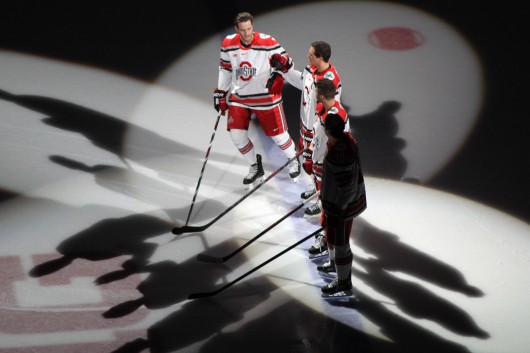
Members of the OSU men’s hockey team are introduced before an exhibition against Guelph on Oct. 4 at the Schottenstein Center. OSU won, 7-1.
Credit: Melissa Prax / Lantern photographer
If it weren’t for the marching bands, there would be no rhythm in college hockey. The weekend-loaded schedule is a killer.
Ohio State men’s hockey team might relearn that lesson this weekend when it comes off a bye week to face Canisius College in Buffalo, N.Y. The Buckeyes, who last played Oct. 18, will face the Golden Griffins nearly two weeks after their last game.
OSU’s bye week has extended its wait to play, but the precedent holds true: college hockey is two days of fun and five days of waiting.
Friday-Saturday series occupy the weekends, then a week of practices invariably zaps a team’s momentum and any buzz created around its recent success.
It’s no fault of the team, practice only goes so far.
For example, the Buckeyes can’t realistically replicate game-like speed and physicality during a midweek practice in an empty rink. Work rate can be heightened, but emotion can’t be feigned.
Point being, five consecutive practices can do only so much and, for better or for worse, they’re key components of the college hockey schedule.
Sure, practices are crucial to a team’s development, but their place in the college hockey schedule tasks them with maintaining any momentum created during the previous weekend.
During a normal two-week set, a team finishes their series on Saturday, then takes the next five days riding the ebbs and flows of the week until Friday. By the time a team begins its next series, last weekend’s momentum is gone.
Granted, the five-day hiatus can be advantageous. In the most recent case with OSU, the break acts as a stopgap after two tough losses, but most noticeably, the break kills the vibe a team takes from a series sweep.
There’s an argument to be made that the Buckeyes might not even benefit from their break because it lasted one week longer than usual. The bye week put OSU in a position where it spent a week coming down from a pair of losses, followed by five days of preparation.
But in the spirit of Halloween, let’s play devil’s advocate and say the Buckeyes benefit from a 13-day break. Even if OSU goes unbeaten in November, its sterling 10-game streak would be, yet again, interrupted by month-long winter break.
For those players hoping to play professionally, the college hockey schedule hardly prepares them for the future. This, among other reasons, is why playing in the Canadian Hockey League is a more attractive option for some prospects.
Those playing major junior hockey play 68 regular season games compared to the typical 34 found on a college hockey schedule.
Understandably, college hockey players are students first and benefit from an uninterrupted week of academics, but is this not true for other NCAA players whose sports schedule midweek games?
Maybe it’s the brutality of the sport and need for more recovery time that separates hockey from other college sports, but if that’s the case, then back-to-back games seem counter-intuitive.
As it is, the Friday-Saturday schedule is a momentum zapper for college hockey teams and the Buckeyes are no exception. Here’s to another restart on Friday.


